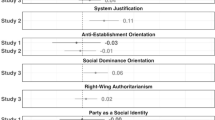Abstract
This study examines the proposition that first ballots predict jury verdicts inaactual juries, an oft-cited finding from Kalven and Zeisel, and the explicit assumption by Kalven and Zeisel that first-ballot preferences are equivalent to predeliberation opinions, referred to as the liberation hypothesis. Interview data from respondents who had served on felony juries indicate that first ballots do predict jury verdicts at a high level. However, it is probable that influence occurs in juries prior to the first ballot, making it unlikely that the distribution of votes on the first ballot is equivalent to the individual inclinations of jurors at the time they enter into deliberation, which casts doubt on the liberation hypothesis. Methodological issues in the study of real juries on these topics are discussed.
Similar content being viewed by others
References
Asch, S. E. (1951). Effects of group pressure upon the modification and distortion of judgments. In H. Guetzkow (Ed.),Groups, leadership, and men (pp. 177–190). Pittsburgh: Carnegie Press.
Bem, D. J., & McConnell, H. K., (1970). Testing the self-perception explanation, of dissonance phenomena: On the salience of premanipulation attitudes.Journal of Personality and Social Psychology, 14, 23–31.
Cook, T. D., & Campbell, D. T. (1979).Quasi-experimentation: Design and analysis issues for field settings. Boston: Houghton Mifflin.
Cowan, C. L., Thompson, W. C., & Ellsworth, P. C. (1984). The effects of death qualification on jurors' predisposition to convict and on the quality of deliberation.Law and Human Behavior, 8, 53–79.
Davis, J. H., Kameda, T., Parks, C., Stasson, M., & Zimmerman, S. (1989). Some social mechanics of group decision making: The distribution of opinion, polling sequence, and implications for consensus.Journal of Personality and Social Psychology, 57 (6), 1000–1012.
Davis, J. H., Kerr, N. L., Atkin, R. S., Holt, R., & Meek, D. (1975). The decision processes of 6- and 12-person mock juries assigned unanimous and two-thirds majority rules.Journal of Personality and Social Psychology, 32 (1), 1–14.
Davis, J. H., Stasson, M., Ono, K. & Zimmerman, S. (1988). Effects of straw polls on group decision making: Sequential voting pattern, timing and local majorities.Journal of Personality and Social Psychology, 55 (6), 918–926.
Dillehay, R. C., & Nietzel, M. T. (1980). Constructing a science of jury behavior. In L. Wheeler (Ed.),Review of Personality and Social Psychology (Vol. 1, pp. 246–264). Beverly, Hills: Sage.
Dillehay, R. C., & Nietzel, M. T. (1985). Juror experience and jury verdicts.Law and Human Behavior, 9, 179–191.
Dillehay, R. C., & Sandys, M. (1993).Life under Wainwright v. Witt: Can jurors make the required judgment? Unpublished manuscript.
Grofman, B. (1976). Not necessarily twelve and not necessarily unanimous: Evaluating the impact ofWilliams v. Florida andJohnson v. Louisiana. In G. Berman, C. Nemeth, & N. Vidmar (Eds.),Psychology and the law (pp. 149–168). Lexington, MA: Heath.
Hastie, R., Penrod, S., & Pennington N. (1983).Inside the jury. Cambridge, MA: Harvard University Press.
Kalven, H., & Zeisel, H. (1966).The American jury. Boston: Little, Brown.
Kerr, N. L. (1981). Social transition schemes: Charting the group's road to agreement.Journal of Personality and Social Psychology, 41 (4), 684–702.
Kerr, N. L., & MacCoun, R. J. (1985). The effects of jury size and polling method on the process and product of jury deliberation.Journal of Personality and Social Psychology, 48 (2), 349–363.
MacCoun, R. J., & Kerr, N. L. (1988). Asymmetric influence in mock jury deliberations: Juror's bias for leniency.Journal of Personality and Social Psychology, 54, 21–33.
Nemeth, C. (1976). Rules governing jury deliberations: A consideration of recent changes. In G. Bermant, C. Nemeth, & N. Vidmar (Eds.),Psychology and the law. Lexington, MA: Health.
Nietzel, M. T., & Dillehay, R. C. (1986).Psychological consultation in the courtroom. New York: Pergamon.
Nisbett, R. E., & Ross, L. (1980).Human inference: Strategies and shortcomings of social judgment. Englewood Cliffs, NJ: Prentice-Hall.
Nisbett, R. E., & Wilson, T. D. (1977). Telling more than we know: Verbal reports on mental processes.Psychological Review, 84, 231–259.
Sandys, M. (1987).Death penalty attitudes and juror voting behavior in felony cases. Unpublished master's thesis, University of Kentucky, Lexington, KY.
Sherif, M. (1936).The psychology of social norms. New York: Harper and Row.
Tanford, S., & Penrod S. (1986). Jury deliberations: Discussion content and influence processes in jury decision making.Journal of Applied Social Psychology, 16, (4), 322–347.
Tindale, R. S., Davis, J. H., Vollrath, D. A., Nagao, D. H., & Hinsz, V. B. (1990). Asymmetrical social influence in freely interacting groups: A test of three models.Journal of Personality and Social Psychology 58, 438–449.
Zeisel, H., & Diamond, S. S. (1978). The effect of peremptory challenges on jury and verdict: An experiment in a federal district court.Stanford Law Review, 30, (3), 491–531.
Author information
Authors and Affiliations
Additional information
The authors wish to thank Lois Chaffins and Jeff Carico for their assistance in conducting the interviews; Steve McKinley and Professors Young Koh, Dualatram Lund and Alexander Weiss for their comments on the statistics, and the anonymous reviewers for the helpful suggestions.
About this article
Cite this article
Sandys, M., Dillehay, C. First-ballot votes, predeliberation dispositions, and final verdicts in jury trials. Law Hum Behav 19, 175–195 (1995). https://doi.org/10.1007/BF01499324
Issue Date:
DOI: https://doi.org/10.1007/BF01499324




